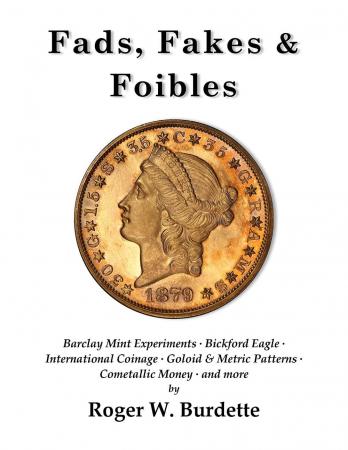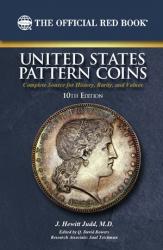Fads, Fakes & Foibles
Purchase
Description
Fads, Fakes & Foibles by multi-award winning numismatic author and researcher Roger W. Burdette brings together a strange crew of idealists and opportunists – creators of the best known, but little understood coinage proposals. Burdette, building on original archival sources, masterfully separates fact from fancy while providing today’s collectors with a delightful journey through some of the oddest coinage proposals ever made.
Most nineteenth century Americans thought of coins and currency in two practical ways: a concern that their pieces of coin or paper currency would be accepted by merchants for purchases and a desire to have more.
For those few involved in economic policy and politics, other, more esoteric aspects of coinage were of concern. Their three principal subjects were prevention of adulteration or counterfeiting, direct equivalence of international gold coins, and use of metric weights for coins. Underlying each of these were certain economic assumptions and profit opportunities that pushed governments toward decisions.
Adulteration and counterfeiting were of concern to all because bad coins meant that merchants and banks would reject the money a person offered in payment. In this regard, it must be remembered that gold coins were simply convenient tokens containing a certain weight of pure gold. Banks and merchants could, and occasionally did, reject legitimate gold coins because they appeared heavily worn or were lighter than official standards. This was the focus of James T. Barclay and his obsession with preventing degradation of the national coinage.
Nickel mining maven Joseph Wharton went to great lengths to promote alloys of nickel and copper for minor coins valued up to ten cents. Here, he cracked skulls with persistent mint officers who thought of base metal coins only as temporary Civil War substitutes for silver dimes and half dimes.
Businessman Dana Bickford, alternatively, was concerned with the ability of travelers to easily know the value of their American money in certain European currencies. His idea for a gold international coin was not intended as a standard of value, but as an equivalency calculator. His changes were of design, not content although much of the work was facilitated by George Dunning, former Superintendent of the New York Assay Office.
Silver producers of the 1870s wanted to stop the decline in silver value compared to gold. Others wanted a bimetallic standard so that gold and silver would circulate equally. Backers of standard international coinage wanted to follow principles of the Latin Monetary Union and have the gold coins of all major nations exactly equal one another. Further, many idealists across the world wanted all coin weights expressed in grams of pure gold or silver and coin diameters and weights to be whole numbers. Here we find Wheeler Hubbell proposing a bimetallic coinage alloy and U.S. coins of metric weight. He was neither first not last to advocate these measures, but was certainly the one most favored by a Congressional committee. Nicholas Veeder, on the other hand, wanted not an alloy but a mechanical union of the two metals much like modern bimetallic coins.
Others proposed to protect coins by adding an iron ring, or striking pieces with one or more holes to permit a convenient diameter while aiding the blind in identifying a coin’s value.
Topics Included:
- Dr. Barclay's Experimental Coinage ~ 1832-1876 -- James T. Barclay's experiments at the Philadelphia Mint are mentioned in many coin collectors' books but rarely explained. Who was this enigmatic experimenter and what did he accomplish?
- Donuts to Dollars ~ 1849-1854 -- An excess of California gold and a shortage of silver encouraged experiments with America's annular gold dollar and half dollar patterns.
- Examination of Counterfeit or Debased Coins ~ 1860 (by Jacob R. Eckfeldt, William E. Dubois and James B. Longacre) -- During and after Dr. Barclay's experiments at the Philadelphia Mint, it was claimed his ideas were not original and had no influence on Mint experiments. Yet his exposition of problems with adulterated coinage evidently inspired internal examination.
- Ring Around the Dollar - A Device to Reduce Abrasion ~ 1867 -- Ignatius Sargent and J. S. Getchell assured the mint director that a metal ring would protect gold and silver coins from abrasion. After all, it worded for wooden buttons.
- Wharton's Folly ~ 1864-1870 -- The Civil War era economy required an unusual decision for United States coinage: should small change be made of high value precious metal, or nearly worthless base alloy? Nickel mine owner Joseph Wharton eagerly promoted his opinion to the Mint Bureau.
- Prevention of a Fraud Upon Our Gold Coins ~ 1873 (by William E. Dubois) -- Mint Assayer William Dubois examined adulteration of gold coins by filling with platinum. His report discussed detection methods and suggested that thinner coins could reduce the frequency of this fraud.
- International Coinage ~ 1865-1868 -- From the 1860s through the 1880s, multiple international conferences were held with the goal of rationalizing financial exchanges. This section introduces coin collectors to the purposes for and outcomes of the discussions.
- The Holey Money of Hall and Johnson ~ 1866-1885 -- Could cutting holes in small denomination coins help alleviate financial inconvenience and loss for much of the working population? Edwin Hall and Eastman Johnson thought they had the answer.
- Bickford-Dunning Gold Exchange Coin ~ 1874-1877 -- Recent research proves that most of the design and promotion of Dana Bickford's International $10 pattern coin was performed by former New York Assay Office Superintendent George F. Dunning.
- Louis Garnett, Wheeler Hubbell, and the Goloid Fiasco ~ 1878-1882 -- Goloid and metric coinage alloy patterns are among the most popular and common of all pieces struck as proposed coinage. The entire episode was expensive, disruptive, wasteful and useless.
- The Cometallic Money Plan ~ 1885-1886 -- Nicholas Veeder was convinced his cometallic money plan would make the word a financial utopia. Few others were similarly persuaded.
Binding: Hardcover
Edition: 1st
Publication Date: June 10, 2021
Size: 8.5x11
Pages: 273


 Coin Price Guides
Coin Price Guides










